Build a better boathouse
Consider your impact on the shoreline when you build a nautical garage
Some boathouses are plain and humble, while others are adorned and dressed to the nines, fulfilling the whimsy of their owners. Often, the character of the shoreline or the size of the body of water is a factor in determining a boathouse’s style. Shallow rivers, for instance, generally call for smaller craft, which require only a modest shelter; big, open lakes call for brawnier boats with boathouses to match. But before you build a dream boathouse, you need a solid plan. First, choose the basic construction elements that will make up your structure, then consider the impact the design will have on your shoreline, as well as the impact to the other inhabitants sharing the lake or river.
A boathouse requires more thought and planning than a dock. It faces more stress from the force of the wind. A boathouse is heavier than a dock, so the crib (the wooden foundation) may be more inclined to sink, and while a sinking dock has its ups and downs, a sinking boathouse brings an unwelcome twist to the building’s walls and roof.
A floating boathouse may have merit where the bottom is sinkingly soft, or where seasonal changes in water levels may see a boat lifted roofward during some parts of the year and lowered toward the bottom at others. However, if you plan to lift the boat in its house for the winter, the solid platform of a crib foundation is more practical. Consider the amount of extra buoyancy needed to lift your craft in a floating boathouse.
Cantilevered docks and boathouses have the least effect on aquatic habitats because they don’t disturb the bottom or interrupt shoreline currents. Floating structures are the next best choice, as they don’t disturb the bottom habitat. (Permits for these two types are less difficult to get.) The merits of each should be weighed against the overall impact on the aquatic and onshore environments. However, there are locations and situations where crib bases for structures are the only practical solution.
“Where possible, the best sites for cribs, or any structure, is where there is a sand or bedrock bottom. Keep the crib offshore as far as possible, a minimum of 2 m, to let water flow along the shore,” says Andy Smith, fish habitat biologist with Fisheries and Oceans Canada in Prescott, Ont. (You can use a ramp to bridge the gap to shore.)
“You have to expect repairs at some point in the future,” Smith adds. “The less you start with, the less it will eventually cost.” He encourages the structure to be as open and as minimal as possible, to allow shoreline currents to flow, to let sunlight reach the bottom and to allow the free movement of fish. As well, you should use staving–the planking that skirts the dock–only where needed. The purpose of staving is to prevent a boat from getting under the dock and to hold boat bumpers that protect the hull. Otherwise, staving is largely cosmetic. Its overuse has a severe impact on the aquatic environment and impedes the movement of fish and wildlife. Where staving is necessary, provide adequate spacing for water flow and light penetration. Better yet, use horizontal boards where wider spacing is more practical. Staving should not extend below the high-water line.
The traditional crib for docks and boathouses is a timber frame of squared lumber, with alternating rows overlapping at the corners. Heavy, threaded galvanized rod runs vertically through holes bored in the ends of each timber. Broad galvanized washers at the top and bottom keep the nuts from burying themselves in the wood. Corrosion accelerates the decay of the timber; therefore, using galvanized hardware resists corrosion for longer.
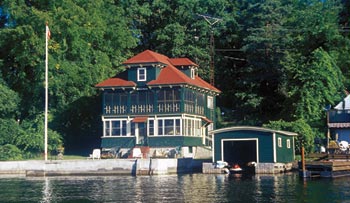 The layered timber frame leaves open every other space on each side of the crib. This arrangement provides two features: an inside surface that allows the rock fill to grip and weight the crib and pore space for small fish and organisms to find refuge. Some builders will bolt a layer of heavy, corrugated galvanized-metal sheeting to the bottom of the crib, to help keep the structure from sinking into sand or other substrate. Metal sheeting also provides a platform for the inevitable rebuilding in the future, possibly 20 to 30 years down the road. Creating a crib with a false bottom provides refuge and shelter space as the rock fill stays above the bottom of the water. This feature helps to reduce habitat loss.
The layered timber frame leaves open every other space on each side of the crib. This arrangement provides two features: an inside surface that allows the rock fill to grip and weight the crib and pore space for small fish and organisms to find refuge. Some builders will bolt a layer of heavy, corrugated galvanized-metal sheeting to the bottom of the crib, to help keep the structure from sinking into sand or other substrate. Metal sheeting also provides a platform for the inevitable rebuilding in the future, possibly 20 to 30 years down the road. Creating a crib with a false bottom provides refuge and shelter space as the rock fill stays above the bottom of the water. This feature helps to reduce habitat loss.
Smith suggests using woods such as cedar or hemlock in construction, rather than pressure-treated material. The former have natural preservatives throughout the timber, and if they can be purchased locally, you will help the regional economy. As it is a violation of the Fisheries Act to remove stone from the lake or river bottom to use as fill for the crib, bring in clean stone native to the area. Use large rock pieces to leave larger interstitial space as habitat and refuge. Do not use concrete or cement pieces as fill–these deteriorate into a smothering sediment.
Some marine contractors have turned to steel cylinders for cribs. These may prove to have a longer life-span than timber; however, the cylinders must have holes cut into them to provide space for shelter and refuge. While some property owners may be able to handle smaller wooden cribs, steel structures most likely mean bringing in the pros.
A boathouse and dock can also be built on pilings. Years ago, wood pilings were used, often with several driven tightly together and bound with ropes or cable. Thick-walled steel tubes are used now. These can be pushed or driven deep into softer bottoms. By using hardened points, they can be driven into gravel and even an overburden of jumbled rock. Marine contractors weld a framework of steel cross-members to the pilings, as stringers for the decking of a dock and the skeleton of a boathouse. As with any dock, the initial construction is fairly invasive, but the footprint of the pilings is relatively small compared to cribs.
At a single dock parallel to shore, there may be an application for an awning cantilevered out over the water to provide shade and shelter for a boat. Such structures are effective if there isn’t exposure to high winds. Another alternative is a boat port: a floating, roofed structure without walls, for summer shelter only.
Whatever the type of structure, building small is practical, but don’t underbuild. With an in-water structure, both the building and ecological costs are high, and costs are not likely to diminish when the inevitable replacement is needed. Strength comes from design and also the materials. Triple-galvanized hardware, big bolts and washers, heavy specialty hinges on ramps, heavy-duty hangers and corner reinforcements–all are available at lumber retailers in cottage country. Look at other boathouses on your waterfront to note where they’ve both succeeded and where they failed, and learn by example.
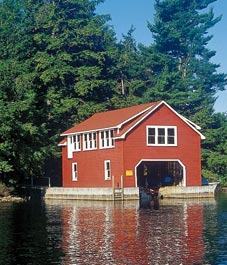 Ice will always be a concern with any type of structure, especially as it melts and moves during the spring thaw. Shifting ice can move or tip boathouse cribs. With rising water levels, ice can lift pilings or push up structures up from under the staving. Structures on exposed shorelines are especially vulnerable. Ice can add extra weight to floating boathouses, as it tends to build up onto and seemingly climb the floats and may tilt the structure.
Ice will always be a concern with any type of structure, especially as it melts and moves during the spring thaw. Shifting ice can move or tip boathouse cribs. With rising water levels, ice can lift pilings or push up structures up from under the staving. Structures on exposed shorelines are especially vulnerable. Ice can add extra weight to floating boathouses, as it tends to build up onto and seemingly climb the floats and may tilt the structure.
Manage the shoreline
When deciding what type of structure to build–or whether to build at all–get to know the character and nature of your shoreline, in all seasons of the year. See what a structure would look like from your neighbour’s view. Study the long-term trends and predictions for your lake or river: where will your water levels be, given water use and climate change, in the decades to come? You need to discover how to have the lowest possible impact on the environment and shoreline.
As real estate agents say, in justification of the high price of waterfront property, “they’re not making any more of it.” Waterfront is precious. Municipal councils, rural and urban alike, face contentious issues of access, water quality, development and redevelopment, conservation, scenic qualities, tax base and much more. Jurisdiction is multiple, layered and overlapping.
Some municipalities, while tempted by increasing the lucrative tax base, realize that bodies of water can handle only a finite investment of cottagers’ capital before they become loved to death. Nutrient loads from lawns, gardens, golf courses and septic systems–particularly where the filter and buffer of shoreline vegetation is removed–quickly age lakes and rivers with rampant growth of algae and aquatic plants. In this context, it’s no surprise that building permits can be hard to secure.
“Shorelines are often called the ribbon of life,” Smith says. He explains that the vast majority of animal life in any region depends upon places where land meets water. Wildlife needs shoreline for habitat, food, water, protection, breeding and spawning. Loss or degradation of the shoreline both below and above the water’s edge directly impacts the ecology of the watershed. “Our guiding principle,” Smith says, “is no net loss of habitat, to keep the productive capacity of the area.”
Smith explains that what may seem to be a hefty layer of regulation for either renovations or new construction is simply a safeguard against undue damage to fragile ecosystems.
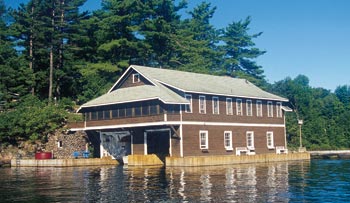 Low-impact designing
Low-impact designing
The design of any waterfront and in-water structure is a critical part of the review and approval process. Keeping environmental impact to a minimum is key.
It’s a violation of the Fisheries Act to remove stumps, logs, fallen trees and rocks from the water. All of these are shelter, forage areas and refuge for fish and other aquatic organisms. Keeping in place the native shoreline vegetation is also important, as it stabilizes the area and filters sediment and nutrients that would otherwise smother bottom-dwelling organisms, which could trigger excessive algae growth.
Proper planning
Smith emphasizes that a responsible attitude to building at the waterfront is to everyone’s benefit, for the quality of the water, the quality of experience and even the quality of the local economy. He suggests that there are subtle and easy ways for property owners to contribute positively to these qualities and go so far as to improve habitat. “Put a small shoal under your dock,” he says, “with a pile of rocks for refuge. This feature will also break waves to protect the shore and provide a place for the kids to see fish up close. Branches or an old Christmas tree sunk under the dock or along the shore enhance habitat, too.”
Your shoreline is, as he says, part of the ribbon of life.
The first rules to consider when designing your boathouse are those by Transport Canada: marine criteria for not obstructing waterways. Your plans must meet industry standards. (Visit www.tc.gc.ca/marine/menu.htm for more information.)
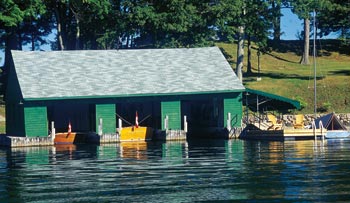 All fish-related issues in Canada fall first to the Department of Fisheries and Oceans. The federal Fisheries Act refers to fish in a very broad sense, which include finned fellows and even invertebrates, crustaceans, eggs, larvae and spawn. The act defines fish habitat as “spawning grounds and nursery, rearing, food supply and migration areas on which fish depend directly or indirectly to carry out their life processes.” To ensure your project has the appropriate approvals and permits, contact your local conservation authority or Natural Resources office. Check out the Department of Fisheries and Oceans website, as well as the Ontario Ministry of Natural Resources. Don’t leave municipal permits out of your approval process as building permits may be needed, and there are likely municipal bylaws to be considered.
All fish-related issues in Canada fall first to the Department of Fisheries and Oceans. The federal Fisheries Act refers to fish in a very broad sense, which include finned fellows and even invertebrates, crustaceans, eggs, larvae and spawn. The act defines fish habitat as “spawning grounds and nursery, rearing, food supply and migration areas on which fish depend directly or indirectly to carry out their life processes.” To ensure your project has the appropriate approvals and permits, contact your local conservation authority or Natural Resources office. Check out the Department of Fisheries and Oceans website, as well as the Ontario Ministry of Natural Resources. Don’t leave municipal permits out of your approval process as building permits may be needed, and there are likely municipal bylaws to be considered.
The Canadian Coast Guard must be informed of any project that has the potential to interfere with navigation of the body of water. To contact the Coast Guard communications branch, call 613-993-0999.
Timing is everything. No permits for in-water work will be issued during spawning seasons. The spawning period varies from region to region, depending on the physical and biological needs of fish species. Generally, the construction season is in late summer. In some locations, work done on or through the ice may be permitted, unless there is a cold-water nursery to be protected. Check with your local Natural Resources office for details.
To leave a comment, please log in

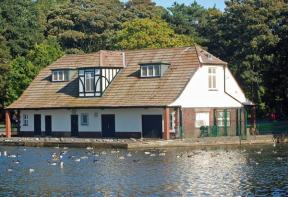










No comments